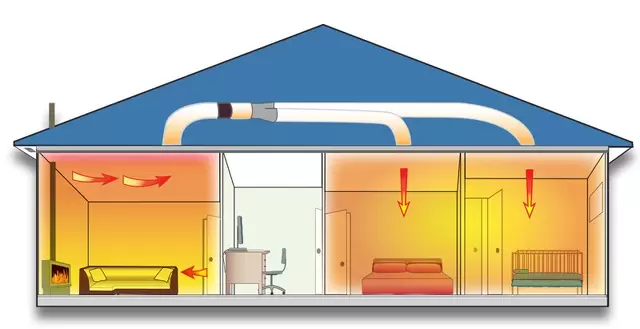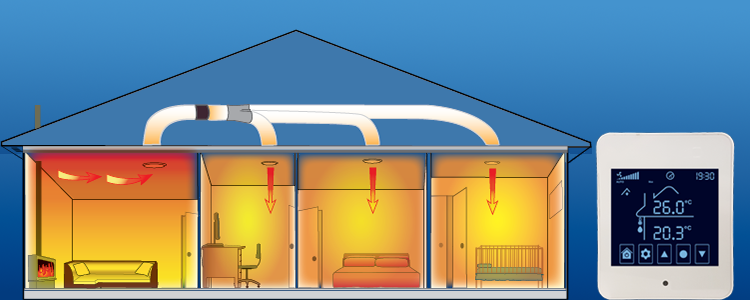A Comprehensive Guide to Picking the Right Heat Transfer Equipments for Your Needs
Choosing the ideal Heat transfer system is crucial for functional efficiency. Various systems deal with different demands, affected by variables such as temperature level range and fluid kind. Comprehending the principles behind Heat transfer, such as conduction, radiation, and convection, is vital. In addition, reviewing energy resources and upkeep techniques can influence long-term performance. A closer evaluation of these factors to consider exposes exactly how to tailor a system to specific needs. What should one prioritize in this complicated decision-making process?
Recognizing Heat Transfer: Trick Ideas and Principles
Heat transfer might seem like a straightforward principle, it encompasses a range of concepts that are basic for efficient system layout - DVS Heat Transfer Systems. Understanding these concepts is necessary for engineers and designers who aim to enhance thermal performance in numerous applications. Transmission, for instance, involves the transfer of Heat via strong materials, while convection refers to the activity of Heat within fluids. Radiation, an additional key concept, describes just how Heat can be moved with electro-magnetic waves. Each of these devices plays a crucial duty in establishing exactly how energy moves within a system. By thoroughly understanding these ideas, specialists can make informed decisions, ensuring that Heat transfer systems operate effectively and fulfill the details demands of their applications
Sorts Of Heat Transfer Solutions: A Review
Recognizing the concepts of Heat transfer prepares for discovering the numerous sorts of Heat transfer systems readily available. Heat transfer systems can be classified mainly into 3 kinds: convection, conduction, and radiation. Conduction entails Heat transfer with solid products, counting on direct contact between particles. Convection, on the various other hand, takes place in liquids (gases and fluids) where the movement of the fluid itself assists in Heat transfer. Radiation involves the transfer of Heat with electro-magnetic waves and does not require a tool, enabling it to occur in a vacuum cleaner. Each sort of system has distinct characteristics and applications, making it crucial for people and organizations to thoroughly evaluate their certain needs when choosing the most appropriate Heat transfer option.
Applications of Heat Transfer Equipments in Various Industries
Heat transfer systems play a necessary role throughout numerous sectors, influencing effectiveness and item high quality. In commercial production procedures, they facilitate accurate temperature level control, while in food and drink processing, they assure safety and preservation. In addition, heating and cooling and environment control systems rely heavily on reliable Heat transfer to preserve comfortable atmospheres.
Industrial Manufacturing Processes

Various industrial production procedures rely greatly on efficient Heat transfer systems to make the most of productivity and improve product quality. In fields such as metalworking, Heat exchangers play an essential duty in preserving optimal temperature levels throughout welding, casting, and forging. These systems guarantee uniform Heat distribution, which is vital for achieving desired material residential or commercial properties. Likewise, in the chemical production industry, Heat transfer systems promote exact temperature level control throughout reactions, impacting return and safety and security. In textile production, reliable Heat management is important for dyeing and ending up procedures, affecting color consistency and material top quality. By picking proper Heat transfer innovations, producers can improve energy effectiveness and lower functional costs, inevitably resulting in an extra competitive and sustainable manufacturing atmosphere.
Food and Drink Handling
Efficient Heat transfer systems are similarly important in the food and drink handling industry, where preserving suitable temperatures is critical for food safety and security and top quality. These systems play an essential function in procedures such as food preparation, sanitation, and pasteurization, making certain that products are secure for consumption and maintain their dietary worth. Heat exchangers, for example, effectively move Heat in between fluids, optimizing power usage while decreasing temperature variations. Additionally, refrigeration systems are basic for extending and preserving perishable items rack life. The selection of Heat transfer technology directly affects functional efficiency and item honesty, making it visit this page important for food and drink suppliers to pick the appropriate systems tailored to their particular processing requirements. This mindful selection ultimately adds to consumer contentment and food safety.

HVAC and Environment Control
While numerous sectors rely upon Heat transfer systems for effectiveness, HEATING AND COOLING (Home Heating, Ventilation, and A/c) plays a necessary function in keeping indoor climate control throughout different setups. These systems use Heat transfer principles to manage air, moisture, and temperature quality, making certain convenience and safety in property, commercial, and commercial atmospheres. Appropriately designed cooling and heating systems boost energy effectiveness, lower operational expenses, and lessen ecological influence. In business structures, for instance, efficient environment control contributes to worker performance and customer contentment. In industrial applications, cooling and heating systems aid maintain optimal conditions for devices procedure and item preservation. Selecting the appropriate Heat More Info transfer system is important for meeting particular climate control needs and achieving overall system efficiency.
Evaluating Power Sources for Heat Transfer Systems
In reviewing energy resources for Heat transfer systems, a contrast of eco-friendly energy alternatives and nonrenewable fuel source considerations is important. Sustainable sources, such as solar and wind, deal lasting options that can minimize environmental effect. Conversely, nonrenewable fuel sources remain common as a result of their well-known framework and power thickness, triggering a careful assessment of both choices.
Renewable Energy Options

Nonrenewable Fuel Source Factors To Consider
Evaluating fossil fuel factors to consider is essential for the performance and sustainability of Heat transfer systems. Nonrenewable fuel sources, such as gas, oil, and coal, are traditional energy sources that give significant Heat output, making them popular choices for commercial and residential applications. However, their environmental effect, including greenhouse gas discharges and resource deficiency, elevates issues. When selecting a warm transfer system, it is vital to evaluate the accessibility, price, and governing elements related to these fuels. In addition, the performance of nonrenewable fuel source systems should be considered, as higher efficiency can alleviate some ecological drawbacks. Inevitably, a well balanced approach evaluating efficiency and sustainability can guide decision-makers toward one of the most appropriate Heat transfer service for their certain click over here now requirements.
Aspects to Consider When Picking a Warm Transfer System
Choosing an appropriate Heat transfer system requires cautious consideration of different variables that can significantly affect effectiveness and efficiency. One crucial aspect is the operating temperature variety, which dictates the products and design ideal for the application. Furthermore, the kind of fluid used in the system-- whether gas or liquid-- impacts Heat transfer effectiveness and compatibility. The system's dimension and capacity should align with the particular needs of the procedure to stay clear of inadequacies. Power source availability is also essential, influencing operating expense and sustainability. The installation atmosphere, including area constraints and access for upkeep, plays a substantial duty in system choice. Regulative conformity and safety and security requirements need to be thought about to guarantee the system fulfills all lawful requirements.
Upkeep and Efficiency Optimization for Heat Transfer Systems
Keeping Heat transfer systems is important for making sure maximum effectiveness and longevity. Normal maintenance activities, such as cleaning up Heat exchangers and checking insulation, help avoid performance losses as a result of fouling and thermal linking. In addition, keeping an eye on system specifications, including pressure and temperature, allows for very early discovery of anomalies, decreasing downtime and pricey fixings. Carrying out a preventative maintenance schedule can optimize performance and prolong the lifespan of parts. Updating to advanced control systems can boost operational effectiveness by changing to varying conditions and loads. By prioritizing maintenance and effectiveness optimization, drivers can accomplish decreased energy intake, reduced functional costs, and enhanced overall system reliability, ultimately causing better source application and an extra lasting operation.
Future Patterns in Heat Transfer Technologies
As industries increasingly focus on sustainability and power effectiveness, future patterns in Heat transfer technologies are readied to undergo significant improvements. Innovations such as advanced products, including carbon nanotubes and nanofluids, promise improved thermal conductivity and efficiency. Furthermore, the integration of renewable power sources into Heat transfer systems is acquiring momentum, promoting eco-friendly solutions. Smart innovations, consisting of IoT sensors, are anticipated to reinvent tracking and control, making it possible for real-time information evaluation for enhanced performance. The advancement of modular and compact systems will assist in less complicated installment and maintenance, catering to diverse applications. These improvements show a shift in the direction of more lasting, effective, and versatile Heat transfer options, aligning with worldwide energy goals and ecological requirements.
Often Asked Inquiries
What Are the Ecological Impacts of Heat Transfer Systems?
The environmental impacts of Heat transfer systems can consist of greenhouse gas exhausts, power usage, and prospective thermal pollution. Furthermore, improper disposal of materials and ineffectiveness can add to source deficiency and ecological community interruption.
How Do I Determine the Cost-Effectiveness of a Warmth Transfer System?
To calculate the cost-effectiveness of a warmth transfer system, one must analyze first expenses, functional costs, upkeep needs, and energy efficiency, contrasting these aspects versus the expected lifespan and performance of the system.
Can Heat Transfer Systems Be Made Use Of in Residential Settings?
Heat transfer systems can indeed be used in residential settings. They offer efficient home heating and cooling down solutions, making homes extra comfy while possibly decreasing energy prices. Their flexibility permits for various applications in household environments.
What Safety And Security Regulations Relate To Heat Transfer Solutions?
Safety and security regulations for Heat transfer systems commonly consist of standards on maintenance, operation, and installation. Compliance with regional building codes, manufacturer specifications, and sector requirements is crucial to assure secure and efficient system efficiency in different applications.
Just How Do Various Products Affect Heat Transfer Efficiency?

Transmission, for circumstances, entails the transfer of Heat through solid materials, while convection refers to the activity of Heat within liquids. Understanding the concepts of Heat transfer lays the groundwork for exploring the different types of Heat transfer systems available. Heat exchangers, for instance, efficiently move Heat in between liquids, optimizing energy use while minimizing temperature level fluctuations. In evaluating energy sources for Heat transfer systems, a contrast of eco-friendly energy options and fossil gas factors to consider is crucial. Steels, such as copper and aluminum, conduct Heat efficiently, whereas insulators like rubber and glass slow down Heat flow.